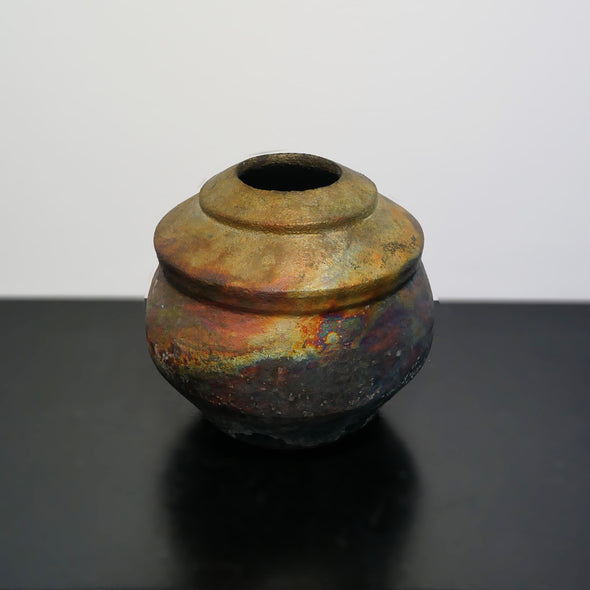
George Blackman
Small Raku Jar
Raku
6" x 6"
$110
GEORGE BLACKMAN
Ceramic Artist
Raku pottery was created in Kyoto, Japan sometime during the second half of the sixteenth century. It was first produced by a potter called Sasaki Chojiro, 1515-1592, and his son, Jokei. Originally they were roof tilers. In 1587, while working on the beautiful pleasure pavilion, Jurakudai, they became close friends with the famous Tea Master, Sen-no-Rikyu. The tea ceremony had recently become revered as a national art in Japan. With Rikyu's guidance, Chojiro and Jokei began making wares exclusively for the tea ceremony. This new pottery style broke away from the restricted forms of fine porcelain the Japanese were used to seeing. The first Raku was soft, low-fired, hand-molded pottery with a thick rich glaze; the surface showed a variety of subdued colors.
Select potters of today employ the same 400-year-old firing technique that Chojirn and Jokei used but add' special glazes and washes to produce more colorful surfaces. This Raku pottery also breaks away from traditional pottery. I think the new colorful surfaces reflect the freedom of the fire, continuing Raku ceramic origins... the Japanese character raku means "enjoyment of freedom".
Each Raku ceramists has his or her own style of firing Raku. George Blackman formulates his own Raku clay body. He then hand throws the form on his potter's wheel; he usually makes Old World pottery forms. After it dries, he fires it in his kiln. The piece is then coated with a high concentration of metal oxides, predominately copper. George then fires it again, this time to 1800 F, when the piece is glowing red. The metal oxides bond to the ceramic surface at this temperature. While red hot, he takes the piece from the kiln and places it in a nest of combustible materials, such as leaves, sawdust and straw. The hot ceramic piece sets the nest on fire. Fire and smoke engulf the piece. As flames glide over the piece, they interact chemically with the metal oxides creating paths of color on the ceramic surface. He then covers the piece with a metal container to create an airtight seal, depriving it of oxygen. This further enhances the chemical reaction with the metal oxides. He removes the container after fifteen minutes and lets the piece cool.
George Blackman 's goal is to produce vibrant, beautiful color on his pottery forms. It is known for its bold coloration. He bas learned over the years many factors interplay to achieve this, such as the timing of each phase, the type of combustible materials be uses and the way the mate1ials are arranged in the nest. He has been firing with this process for eighteen years and is always astonished at the colors that he gets. The chemical reaction with the spontaneity of the fire consistently creates a colorful, one-of-a-kind art piece. Each piece is a joy to design and "paint" with fire!
After working in functional stoneware and porcelain for many years, I needed more of a challenge in my work, particularly in glazing. I have always been attracted to color, fire and ancient pottery forms. Currently my work in Raku gives an aliveness of color and form that is extraordinary and involves the most intimate contact with the fire in the ceramic process.
I became intrigued with working and creating in clay while taking elective ceramic courses at James Madison University in Harrisonburg, Virginia. I was introduced to, Raku by my Japanese instructor, Masako Miyata. I moved to Illinois and began my career throwing functional pottery. In 1981 my desire to express myself more creatively in my work led me to experiment with Raku again. With more direct exposure to the fire, my one-of-a-kind creations were more challenging and exciting to make. As my work evolved, I developed a unique style using traditional white crackle and the brilliant colors of a copper matte finish with the old ceramic forms. My vessel forms and wall pieces are now known for their artifact type quality. The results of my work is ceramic art created by man, earth and fire... flame lives on in the color, man's eternity echoes in the earthen form.